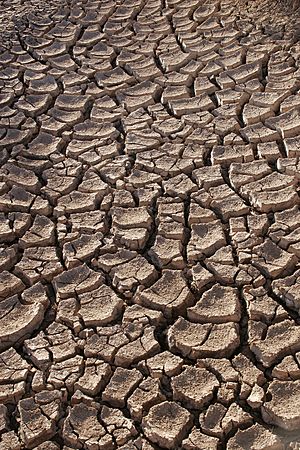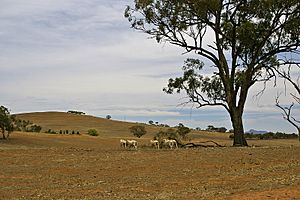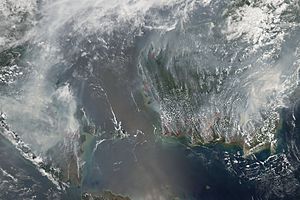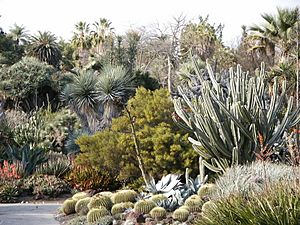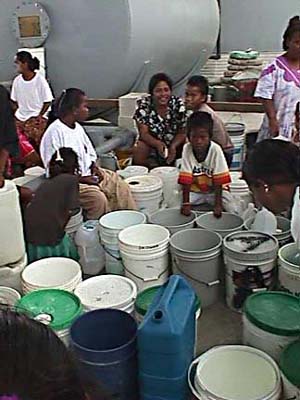Drought facts for kids
A drought is a long time of very dry weather. During a drought, an area gets much less rain than usual. Droughts can last for months or even years.
Plants and crops need water to grow. Animals need water to live. So, droughts can be very dangerous. When there isn't enough water, people can face famines (a time when there is not enough food). Sometimes, new deserts can even form. Many people suffer because of droughts, especially in places where farmers grow food just for their families. Sometimes, droughts can even lead to arguments or conflicts between people.
Droughts are often natural events. They can be caused by weather patterns like El Niño or high-pressure systems. Global warming can also play a part. But people can also cause droughts. For example, cutting down many trees (Deforestation) without planting new ones can lead to drought. Also, changing the path of rivers or emptying lakes can cause dry conditions.
It's often hard to know exactly when a drought begins. This is because droughts usually start slowly. Their effects build up over a long time. They can even continue for months or years after the rain returns.
Contents
What Causes Droughts?
Not Enough Rain
Water falls from the sky in different ways:
- As liquid rain.
- As liquid rain that freezes when it hits the ground.
- As ice, like snow or hail.
Droughts happen mostly in places that don't get much rain normally. If it rains just a little less than usual over time, a drought can start. Wind can also make a drought worse. If a dry wind blows (like from over land), it can dry out the ground faster than a wet wind (like from over the ocean).
Dry Season
In the tropics (areas near the Earth's equator), there are clear wet and dry times of the year. During the dry seasons, the air becomes very dry. This causes water holes and rivers to dry up. Many grazing animals like zebras, elephants, and wildebeest must then move to find water. If they don't, they might die. Plants also ripen faster because more water leaves them. Bushfires are also common during the dry season because plants are very dry and can catch fire easily.
El Niño
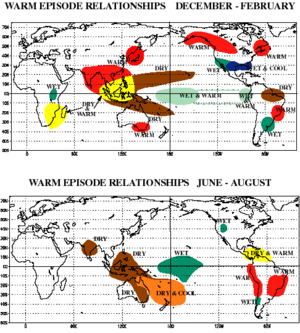
El Niño is a natural event. It happens when the ocean water in the tropical Pacific Ocean gets warmer. This change affects air pressure between the Pacific and Indian Oceans. Since air pressure controls weather, El Niño can cause droughts in some parts of the world and heavy rain in others.
Erosion and Human Actions
Erosion is when natural forces like wind, water, or gravity move or wear away the Earth. In dry places, wind is the main cause of erosion. Because the soil is already dry, wind can easily pick up small bits of dirt and move them. These flying particles can also rub against other things and wear them down. Wind erosion usually happens where there isn't enough rain for many plants to grow.
Loess is a type of soil that wind erosion affects a lot. It looks like small sand cliffs. It's common in the middle of the United States and other places like China. Farmers plant windbreaks (like large trees or bushes) near loess to help block the wind.
People's actions can also cause or worsen droughts. Cutting down forests (Deforestation) removes trees that help keep moisture in the soil. Farmers sometimes use slash-and-burn methods to clear land for crops. This can make the soil dry and prone to erosion.
Climate Change
Scientists believe that global warming will cause more droughts. They say that while the world might get more rain overall, areas that already tend to be dry will become even drier. Some ideas to fight global warming, like using a space sunshade, might also increase the chances of drought.
Kinds of Droughts
As a drought continues, its effects get worse. People define droughts in three main ways:
- Meteorological drought happens when an area gets less rain than its average for a long time. This type of drought usually comes before others.
- Agricultural drought affects how well crops grow or the natural environment of an area. This can happen if farms are not planned well. It also happens if plants can't get enough water, or if erosion occurs. A lack of rain can also harm farming.
- Hydrological drought happens when water in places like underground water sources (aquifers), lakes, and reservoirs drops below normal levels. We see the effects of this type of drought more slowly. This is because it involves stored water that is used but not refilled. It can be caused by people using too much water or by a lack of rain.
What Happens Because of Droughts?
The problems caused by droughts can be put into three groups:
- Environmental: Water levels drop, and rivers flow less. This is bad for animals that live in water. Water pollution can get worse. Wet areas dry out, leading to more and bigger fires. Wind erosion happens more easily. Plants struggle to survive because of no water, and also from pests and diseases. Animals have to move to find water and food.
- Economic: Farming becomes less successful during a drought. This means food prices go up because there is less food to sell. It's harder to care for farm animals. Forests have fewer healthy trees and animals. Making energy from water (hydro plants) decreases. Even tourism can drop because water activities are affected.
- Social: People's health can suffer from heat waves and having to use less water. People can get stressed because food costs more and their normal lives are disrupted. Droughts can also make snakes move closer to homes looking for water and food, leading to more snake bites. Poorer countries have more trouble with water shortages. They might have to move because of pollution or lack of water. Sometimes, people or countries might even fight over food and water.
History of Droughts
Droughts are a normal part of the climate cycle in most parts of the world. They are mentioned in ancient stories like the Epic of Gilgamesh and the Biblical story of Joseph. Historians think that people moved out of places like Chile and Africa thousands of years ago because of droughts.
Some well-known historical droughts include:
- In 1900, a drought in India caused many deaths.
- From 1921-22, a drought in the Soviet Union led to over 5 million deaths from hunger.
- From 1928-30, a drought in Northwest China caused over 3 million deaths from hunger.
- Droughts in Sichuan Province, China, in 1936 and 1941 caused millions of deaths.
- The 1997-2009 Millennium Drought in Australia led to a big water problem. Many desalination plants (which remove salt from seawater) were built.
- In 2006, Sichuan Province, China, had its worst drought in modern times. Nearly 8 million people and over 7 million cattle faced water shortages.
- A 12-year drought in parts of Western Australia, South Australia, Victoria, and Tasmania was very severe and unlike anything seen before.
- In 2005, the Amazon basin had its worst drought in 100 years.
- Repeated droughts in East Africa have caused desert areas to grow. This is called desertification.
- In 2012, a severe drought hit the western Sahel region. 10 million people were at risk of hunger, and nearly $1 billion was sent to help.
How We Can Protect Against Droughts
Farmers can help reduce the effects of drought by watering their crops carefully and rotating them (planting different crops in the same field each year). Groups like the Natural Resources Conservation Service help protect soil.
Here are some ways we can protect against droughts, lessen their effects, and help those affected:
- Cloud seeding: This is a way to try and make it rain on purpose. Scientists are still studying if it really works.
- Dams: Many dams and their reservoirs (large lakes behind dams) store extra water for dry times.
- Desalination: This process removes salt from seawater. It can create more fresh water for drinking and watering plants.
- Drought Monitoring: If we watch and measure rainfall levels closely, and compare them to how much water people are using, it can help prevent droughts caused by humans.
- Land Use: Carefully planning how we use land can help. For example, planting crops that need less water in dry years.
- Outdoor Water-Use Rules: Limiting how much water people use outside their homes (like for sprinklers or washing cars) can save water. In dry places, people often use Xeriscaping for their yards. This means designing gardens that need little or no watering.
- Rainwater Harvesting: We can collect and store rainwater from roofs or other surfaces. This collected water can then be used instead of hose water.
- Recycled Water: Used water (sewage) can be treated and cleaned. This "recycled water" can then be used again for things like watering parks.
- Transvasement: We can build canals or change the path of rivers to send water to areas that are dry.
Interesting Facts About Drought
- Drought is a time when the land gets too dry.
- Droughts can happen because of nature or because of human actions.
- When areas don't get enough rain, a drought begins.
- Weather patterns can cause droughts.
- When soil wears away (Erosion), it can make droughts worse.
- Humans can cause droughts by cutting down forests or using too much water.
- Droughts have serious effects: They can harm the environment and living things, change a country's economy, and affect people's health.
- There are many ways people can help prevent droughts and help areas that often get dry.
Images for kids
-
Fields outside Benambra, Australia suffering from drought conditions in 2006.
-
After years of drought and dust storms the town of Farina in South Australia was abandoned.
-
Affected areas in the western Sahel belt during the 2012 drought.
-
Lake Chad in a 2001 satellite image. The lake has shrunk by 95% since the 1960s.
-
A South Dakota farm during the Dust Bowl, 1936
See also
 In Spanish: Sequía para niños
In Spanish: Sequía para niños


